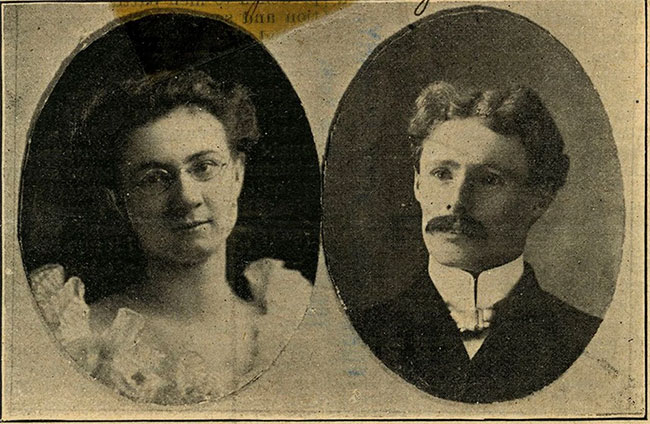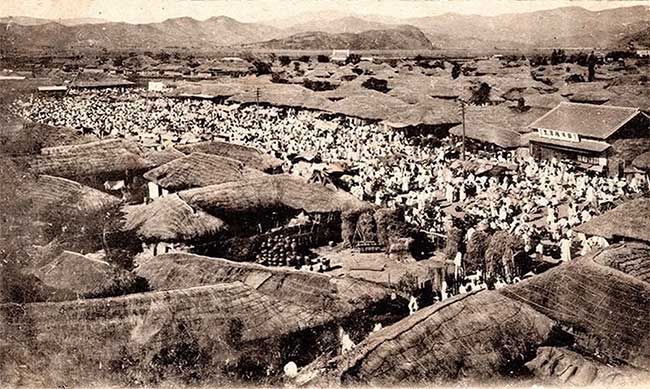Legend of the first piano in Korea
Back in March 1900, when the streets and markets of Daegu city were filled with anticipation and surprise. People talk about the appearance of a "ghost box" - a magical box that emits strange sounds they have never heard before.
Daegu and the "ghost box"
The "spooky box" - known internationally as the "piano" - was given to two missionaries, Richard and Effie Sidebotham, as a parting gift from their friends and family.

Missionaries Effie and Rev. Richard H. Sidebotham.
The Sidebothams then went to Korea in November 1899 and spent at least a few weeks in the capital, Seoul, before being assigned to the city of Daegu. Once settled in their new home, they gave the residents their most cherished items – including a piano.
On March 26, the piano, "well preserved for ocean travel", was taken up a river in Busan and down the Nakdong River to the Samunjin ferry terminal in Daegu city. A team of 31 men escorted the piano to Korea and carried it to the missionaries' residence on March 28.
An article that appeared on the homepage of the Presbyterian Historical Society recorded that Koreans in Daegu did not initially like the appearance of the piano because it made a very strange noise. That's why, at that time, the new guitar was called "ghost box". But eventually this piano became part of the legend and culture of the city of Daegu.
In 2013, the Daegu Daily announced it was the first piano in Korea. The person who discovered the truth was Sohn Tae-ryong, President of the Korean Music and Literature Association,
The letter donated in 2009 by the Sidebothams family to the Busan Museum proves this fact, and it seems quite surprising that so many people have accepted this statement as fact.

Daegu Market in the early 20th century.
Pianos of the 80's and 90's
In the spring of 1884, 34-year-old Edward H. Parker was appointed to the city of Busan as British deputy consul. At this time, the expat community in Busan mainly consisted of Japanese merchants and a small number of Westerners working for the Korean Royal Customs.
Parker's presence in the Busan community was greatly appreciated because he was a very well-educated person (he studied Chinese between 1869-1871), knowledgeable about many cultures due to frequent frequently traveled (visiting Mongolia as well as various ports throughout Asia) and was musically gifted.
In a letter to her family in America, Jenny Lovatt (wife of Busan Customs Commissioner William Lovatt) wrote in May 1884: "Mr. Parker brought a piano, the first piano in Fusan […] Busan]".
For nearly a year, Mr. Parker played for friends and visitors with his excellent piano playing, but at the end of May 1885, he was transferred to Seoul. Jenny was deeply saddened by Parker's passing because he had a "perfect piano".
Parker may have brought his piano with him to Seoul, but - judging from the events of the next few years - there probably isn't much time for him to play good music.
Besides, by the 1890s, there were at least a few pianos in the capital city of Seoul - and not just in missionaries' homes.

Missionary Effie Sidebotham recreated the Korean fashion of the time through a series of undated drawings.
In September 1894, a concert was held at the Seoul Union by three members of the American Legation Guard. According to one of the guests, "music was playing out on the porch and the soldiers sat outside, it was a great night".
Some of the music officers played mesmerising music from the piano, guitar and banjo. In addition to performing in the army, the wife of a Russian architect also contributed with her own singing. A sumptuous dinner is served in the library room and "there is no better combination".
American Ambassador to Korea John Sill also brought a piano with him when he arrived here in 1894. In his letter home, he did not write much about his piano, but instead wrote about the barrel. transport herds that have later been converted into flower beds for houseplants. He carefully strung his vines and named his small space "The Hanging Garden of Babylon".

Portrait of Richard H. Sidebotham in 1907 and a letter to the Foreign Missions Department of the Presbyterian Church in America.
Before 1900, a large number of pianos appeared in Korea. Mr. RD Mackie, representative of Robinson Piano Co., (with offices in Shanghai, Hong Kong and Singapore) arrived in Seoul on July 10, 1898, and spent a week "repairing and tuning the piano. piano".
Later that year, when Ferdinand Krien (Germany's representative in Korea) left Seoul, he sold most of his household goods, including "a fine British piano (made by Collard & Collard, London) made), an almost new high-end bicycle, and a British saddle and bridle that couldn't be better.
It is also more likely that the Korean palace also owned a piano before the "first piano in Korea" of the Sidebothams family. According to the November 1901 edition of Korea Magazine (an English magazine published in Seoul):
"About 2 a.m. on the 16th, one of the houses at the back of the Royal Library, just west of the US Legation, caught fire for unknown reasons. If any help had been given, the fire would have been possible. was easily contained before the fire spread to the main building. But the place seems very deserted and we have lost a very valuable Government building. In the Library there are many valuable books and all. were destroyed along with their belongings, including a piano."
So where is the "first piano in Korea", that question is probably a long time to find the most accurate answer.

Richard Sidebotham's obituary of 1908.
- Robot 19 fingers playing the piano
- The mechanic suddenly discovered the golden treasure in the ancient piano
- Teresa Carreño - 'Piano Goddess' came to the White House from the age of 9
- Blind cat playing the piano
- Legend of Beowulf legend
- Beautiful pictures of Korea in the cold winter
- North Korea and incredible but incredible things!
- Poisonous: Korea is as beautiful as paradise that surprised the world
- Turn iPad into mini piano
- Grus Japonensis red hat cranes
- Microsoft is 'losing' in Korea
- Korea: Promote the use of clean fuels
 The most famous scientific failures in history
The most famous scientific failures in history Mysterious genius mechanic and the machine froze time
Mysterious genius mechanic and the machine froze time The son carries the 'bad gene' of genius Albert Einstein
The son carries the 'bad gene' of genius Albert Einstein Isaac Newton
Isaac Newton